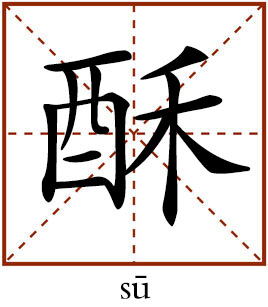Butter

This character usually refers to dairy products, such as butter. When used as an adjective, it describes something that is flaky, crispy or fluffy.
天街小雨润如酥
tiān jiē xiǎo yǔ rùn rú sū
Tian jie refers to the streets in Chang’an, the capital of the Tang Empire. Xiao yu means mild rains. Run is an adjective describing something that is moist. Ru means “like” or “as” while su refers to butter. This line, taken literally, means that the rain in Chang’an is as smooth and soft as cream.
This is a line from a noted poem titled “Early Spring in the Capital: To Zhang Ji.” Its author is the Tang poet Han Yu (768–824). Han composed this poem in 823. He had invited his friend, Zhang Ji, several times to take a spring holiday out, but Zhang declined citing his age and busyness. Han therefore composed this poem about a lovely spring day and gave it to Zhang as an invitation—“The fine drizzle has turned the fine streets creamy—/ New grass, visible from afar, vanishing when near./This, my friend, is the best time of the spring, of the year—/ Absolutely the best—before hazy willows becloud the city.”
The first half of the poem is the most famous. The key word “su” vividly depicts the characteristics of the mild rain in early spring—moist, soft and smooth, just like cream. The second line ingeniously highlights a detail in nature that people seldom pay attention to. Newly grown grass seems to blend together in the distance to become a continuous pale green on the horizon. However, when one gets closer, the green mass vanishes into tiny grass that is scattered sparsely all around. These two lines reflect the poet’s interest in the details of daily life and in particular the celebration of nature.
The last half of the poem praises early spring as the best time in the year, much more beautiful than late spring as flourishing willows becloud the city. The reason to prefer scattered green grass to flourishing willows is because the grass in early spring represents the advent of new life after a long winter, symbolizing vitality, hope and refreshing beginnings. When it comes to late spring, almost all the plants and animals have returned in vigor and the hazy willows seem to not be so special.
edited by REN GUANHONG
